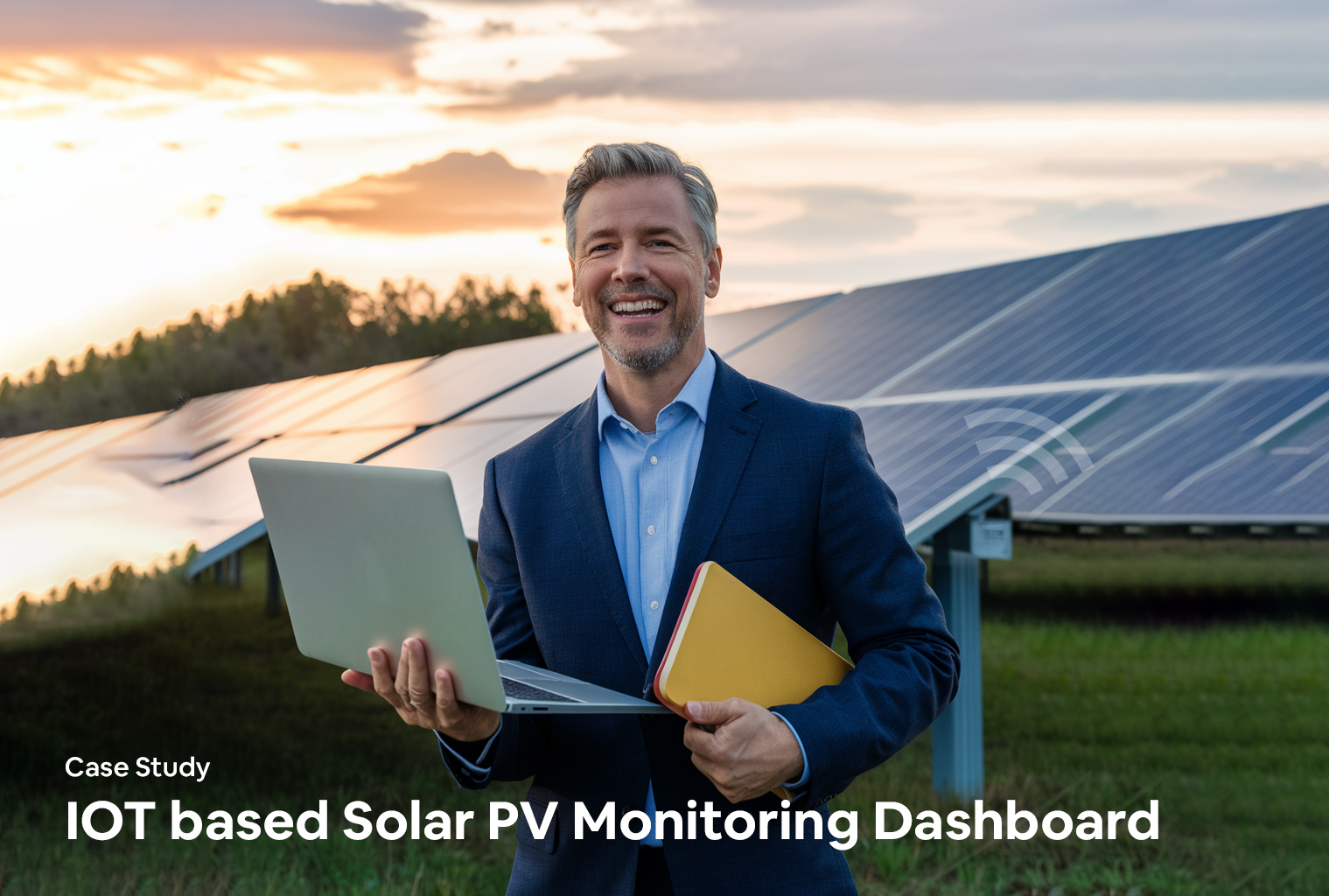This case study explores the design and development of an IoT-based solar PV monitoring dashboard for a Singaporean renewable energy company managing multiple solar plants across India. The energy monitoring software utilizes real-time data from IoT devices to provide insights into solar production at various locations. Traditional methods for managing solar plants often involve manual data collection and analysis, leading to inefficiencies and inaccuracies. This solar PV monitoring dashboard addresses these challenges by offering a centralized platform for data visualization and analysis.
Client Overview:
Our client, a medium-sized renewable energy company based in Singapore, operates a network of solar plants in India. India’s booming renewable energy sector, experiencing a 40% CAGR (as of May 2024), necessitates efficient tools and technologies for solar plant management. This solar PV monitoring dashboard empowers them to monitor multiple plants on a single platform, gaining valuable insights through detailed visualizations.
The project aimed to create a multi-solar plant monitoring dashboard with multi-user access, allowing the company and its customers to track solar production and make informed decisions regarding daily energy use. This transparency facilitates solar production forecasting, enabling strategic energy source planning for both the company and its customers.
Challenges Faced:
The client previously struggled to analyze the vast amount of IoT data generated by their solar plants, hindering their ability to gain valuable insights into daily production. Additionally, their customers lacked visibility into their own solar production and energy usage, making it difficult for the client to accurately plan customer energy needs and related activities. Billing customers based on solar production also posed a challenge due to the cumbersome manual processes involved.
Problem:
Managing and analyzing data from multiple geographically dispersed solar plants using spreadsheets was a time-consuming and error-prone process. The sheer volume of big data received from on-site IoT devices made traditional methods like Excel and legacy software impractical for data analysis and monthly billing generation. Furthermore, reporting plant faults and offering real-time production access via the cloud proved challenging.
Our Approach:
We began by meticulously identifying all crucial data points required for the solar monitoring system. A clear understanding of project requirements and the necessary calculations facilitated data acquisition from the IoT devices. Considering the project’s high scalability potential, we constructed a foundation that could accommodate future growth. After defining the dashboard’s functionalities and complexity, we selected the most suitable technologies to ensure future scalability. Agile methodologies enabled us to incorporate client feedback seamlessly throughout the development phase, crucial for this innovative project with novel customer service features.
Solution Implemented:
Our initial step involved analyzing device data from the solar plant’s IoT devices. In collaboration with the manufacturer, we determined the data types and frequencies transmitted by the devices. Based on this information, we opted for the MQTT protocol for device communication.
Client Inquiry: What is the MQTT Protocol?
Response: MQTT, commonly used for machine-to-machine (M2M) communication and IoT applications, is a lightweight, efficient protocol ideal for low-bandwidth, high-latency, or unreliable networks. It boasts ease of implementation and scalability to support millions of connected devices. Considering these advantages, we recommended MongoDB Atlas with AWS IoT Core.
Client Inquiry: What is AWS IoT Core and How Does it Help with Device Communication?
Response: AWS IoT Core offers an MQTT SDK to facilitate device communication.
Client Requirement: Ease of management, seamless integration, and built-in security features were crucial for the client. Therefore, we opted for AWS IoT Core. While direct MQTT use offers greater control and minimal latency, managed services like AWS IoT Core provide end-to-end security and scalability. Additionally, AWS IoT Core seamlessly integrates with other AWS services like Lambda, S3, and DynamoDB, simplifying data processing, storage, and analysis workflows. Moreover, built-in security features such as device authentication, encryption, and access control ensure data privacy and integrity.
For the front-end and back-end technologies, we selected React.js and Node.js with the LoopBack 4 framework.
Why React.js?
- Virtual DOM: React’s virtual DOM enables efficient UI updates, enhancing performance.
- Reusability: Components can be reused across the dashboard, promoting code efficiency and maintainability.
- Large Ecosystem: React has a vast ecosystem of libraries and community support, facilitating development and scalability.
https://www.monocubed.com/blog/why-use-react
Why Node.js with LoopBack 4 Framework?
- Scalability: Node.js is highly scalable, capable of handling a large number of concurrent connections, essential for real-time data processing in the dashboard.
- JavaScript Everywhere: Using JavaScript on both the front-end and back-end reduces context switching for developers and promotes code consistency.
- LoopBack 4: Provides a powerful framework for building RESTful APIs with minimal effort, speeding up development time.
https://loopback.io/doc/en/lb4
Additional Technologies Adopted:
- MongoDB Atlas
- AWS Cloud Services (EC2, Lambda, S3)
Results Achieved:
The successfully implemented project provided seamless integration and communication with IoT devices across the client’s various solar plant locations in India. Customers now have access to their plant’s solar production data, enabling them to plan their energy resource needs using the dashboard. The dashboard generates monthly analyses of energy production and fault details, empowering both the client and their customers to make data-driven decisions.
Key Takeaways:
At Kapreign, we believe project success hinges not only on technology but also on effective communication and teamwork. A detailed project requirement analysis facilitated the identification of project prerequisites. Clear and consistent communication with the client’s team ensured smooth project execution. Adopting agile project management fostered a win-win situation for both the client and our development team. The project’s development phases were adjusted based on client change requests. The agile framework enabled us to identify project milestones more readily and anticipate the future needs of the dashboard.
Conclusion:
This solar PV monitoring dashboard exemplifies the success achievable through teamwork, strategic technology selection, and robust communication channels. Utilizing scalable technologies fostered a positive outcome for both the development team and the client. By leveraging the right tools and technologies, we delivered a solution empowering our client and enabling data-driven decision-making for their customers across India.


Leave a Reply